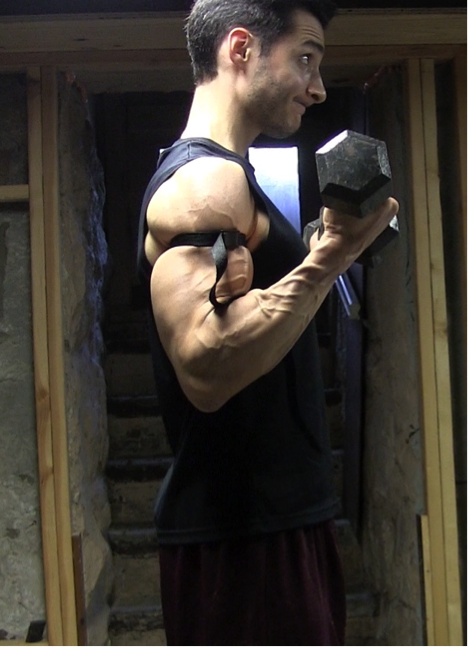I’m still in Florida enjoying my vacation (and eating copious amounts of carrot cake). Actually, after reading this article myself and looking at all the jackedness, I’m kinda grossed out by how much carrot cake I’ve been ingesting.
Nevertheless, if you’ve ever been curious as to whether or not there’s any validity to blood flow restriction training and whether it’s something that’s a good fit for you today’s guest post by Dr. Nicholas Licameli will help answer those questions.
Enjoy.

NOTE: Be sure to check with a healthcare practitioner before using blood flow restriction, especially those with cardiac or circulatory pathologies.
For a more in depth look at this topic as well as explanations and details of the studies referenced, be sure to check out my podcast HERE.
Blood Flow Restriction Training: Real Deal or Are We Wrapped Up in the Latest Fad?
In order to fully understand the theory behind BFR, it’s important to quickly review how blood flows through the body. This quick review of the circulatory system also appears in my article on compression garments, which can be found right here.
“The system is a cycle with the heart at the core.
Oxygenated blood enters the heart and is pumped (with great force) into the arteries. The arteries carry oxygen rich blood to all the tissues of the body, including muscle.
For simplicity, let’s use the biceps as an example.
As the arteries approach the muscle, they become thinner and thinner until they become so thin that the nutrients and oxygen diffuse across its walls and into the tissue. These super thin blood vessels are called capillaries.
After the blood “drops off” its oxygen and nutrients, it is picked up by more capillaries, which feed into larger blood vessels called veins. The veins passively carry the deoxygenated blood back to the heart. Once back at the heart, the deoxygenated blood gets sent to the lungs to get re-oxygenated, sent back to the heart, and is pumped back into the arteries to start the cycle all over again.
So the force from the initial pump from the heart is enough to send the blood from the heart, through the arteries, through the capillaries, into the veins, and back to the heart all while fighting gravity, plaque build up, etc. (pretty amazing huh?).
So it is easy to see that the velocity of blood flow is MUCH greater in the arteries than it is in the veins. Think of pushing a toy car across the floor. The initial push (the heartbeat) gives the car a decent amount of velocity, however as the car travels further and further away, its velocity lessens.”
What Is Blood Flow Restriction Training?

The goal of BFR training, or occlusion training, is to maintain arterial inflow of blood while occluding venous return during exercise: We want to get that nutrient, hormone, and oxygen-rich blood to the muscle, while delaying its escape.
This is accomplished by the application of a blood pressure cuff, knee wrap, or anything that can be tightly secured around the most proximal (closest to the midline of the body) part of a limb. If we use the arm muscles as an example, the wrap would be tightly secured around the upper arm, as close to the shoulder as possible, causing the blood to pool in the arms.
It is thought to have a positive effect on hypertrophy while using much lighter loads than conventional weight training.
How is it possible to restrict venous return without restricting arterial flow?
Let’s think back to our circulatory system review.
The blood in arteries has a much higher velocity and propulsion force than the veins, so in order to occlude arterial blood flow, a much higher pressure is needed. It is easier and requires less pressure to restrict blood flow in the veins because at that point, the flow of blood is not as forceful. Think of in the movies when someone gets an injury and the blood is squirting and pulsing out. The movie is depicting an arterial injury because of the high velocity of blood.
If a vein were injured, the blood would just ooze out.
Note From TG: I added this scene from Kill Bill because 1) why not? and 2) it repeatedly shows “arterial injuries” Nick referred to above. Also, 3) it’s badass.
How Does It Work?
The exact mechanism by which BFR works is unclear, however, the most likely and agreed upon theory has to do with greater metabolic stress.
Muscles release growth factors and metabolic by-products, such as lactic acid, into the bloodstream as a result of resistance training. These growth factors and metabolic by-products are washed away with normal blood flow. By restricting venous return and allowing the blood to pool, these growth factors and metabolic by-products remain in the muscle for a longer period of time and therefore have more time to interact with corresponding receptors in muscle tissue.

The accumulation of metabolic by-products, such as lactic, increases intramuscular acidity and may promote hypertrophy as well as the release of growth hormone (although acute increases in growth hormone have not been shown to significantly impact hypertrophy, it is still worth noting).
The increase in acidity and the buildup of lactic acid are responsible for “the burn” that we all know and love.
Even though we love the feeling, our bodies do not.
Our bodies fight tooth and nail to increase oxygen flow to the area in order to decrease the acidity and restore homeostasis. It does this by increasing respiration (increased breathing rate) and increasing arterial/oxygen-rich blood flow (vasodilation…the pump), but it can only fight for so long.
When the body is no longer able to manipulate breathing and blood flow enough to balance the acidity of our tissues, we enter an anaerobic (“no oxygen”) state. As we keep working through the burn, the acidity continues to increase until we reach muscle failure. Type II muscle fibers are recruited during this anaerobic state, which is important because they have the most potential for growth.
Blood flow restriction increases the amount of deoxygenated blood in the area, which helps facilitate the creation of an anaerobic environment. The result? We reach an anaerobic environment faster and for a longer duration.
How Do We Do It? How Tight? What Set & Rep Ranges? How Often?
As mentioned above, apply the wrap at the most proximal area of your arms and legs. It is difficult to establish an optimal tightness of application due to individual factors such as limb circumference, body fat level, skin thickness, etc. Studies seem to agree on is a simple rating of 7/10 self-rated tightness.
Photo Credit: John Rusin
Perform 3-5 sets to failure with 20-50% of 1 rep max with the muscle occluded the entire time. Rest periods should be 30-60 seconds between sets. After the final set, remove the wraps and restore blood flow to the muscle.
As far as how often BFR should be used, it is my personal opinion that BFR should be used like any other intensity technique that aims to increase metabolic stress, such as rest pause, drop sets, etc.
Is BFR Better Than Just Lifting Weights? I Mean, People Have Been Lifting Heavy Things and Getting Bigger and Stronger for Centuries…
Keep in mind that research only points us in the right direction for further study and isn’t meant to be the end-all be-all.
Research gives us trends and averages, however we each are n=1.
That being said…
Research shows that BFR training may be more effective for hypertrophy than conventional hypertrophy training with matched loads and just as effective as conventional training with unmatched loads.
This means that BFR causes the same amount of hypertrophy as conventional training while using significantly lighter loads. BFR training has been shown to enhance hypertrophy with weights of about 20-30% of 1 rep max, which is significantly lighter than what is typically required for conventional training.
When comparing BFR training to conventional strength training, research has shown BFR and conventional training to have a similar effect on strength with unmatched loads. This means that lifting lighter loads with BFR can increase strength just as much as conventional training with heavy loads.
When loads were matched (both groups lifting the same weight), BFR was shown to improve strength to a greater degree than conventional training.
That being said, there are studies that show BFR to be inferior to conventional heavy training to improve strength. Research supports that, when it comes to strength, specificity of training is key.
What’s the take home regarding strength? As the saying goes, “If you want to lift heavy things, you have to lift heavy things.”
BFR has also shown some promising results in physical therapy and rehabilitation.
Research has shown that subjects experienced increased serum growth hormone, thigh muscle size, and 1 rep max isometric strength just by walking on a treadmill with BFR applied to the legs.
Research also shows that when BFR was applied to the legs following ACL reconstruction surgery, subjects experienced more strength retention and less atrophy when compared to a control. Strength retention and less atrophy were also observed using BFR following a period of ankle immobilization and a non-weight bearing protocol.
It seems BFR may be quite an effective tool with a wide variety of implications. Variables such as power, speed, endurance, etc. still require further investigation at this time.
Is It Safe?
Be sure to check with a qualified 1healthcare practitioner before adding BFR to your training toolbox.
Contraindications to blood flow restriction training include a history of deep-vein thrombosis, pregnancy, varicose veins, high blood pressure and cardiac disease.
Excessive pressure and prolonged ischemia (decreased blood flow) can lead to necrosis of tissues (cell death). Even though the BFR guidelines outlined in this article do not use excessive pressure and are not being applied for long periods, caution should always be taken.
Stop use immediately and consult a qualified healthcare practitioner if you experience severe pain, dizziness, nausea, or numbness/tingling.
Keep in mind that every time you enter the gym, you are taking a risk. If not respected or properly executed, anything can be harmful. Even with perfect form, injury is a risk.
What’s the Take Home?
- With BFR, the goal is to induce fatigue, blood pooling, and muscle burning quicker and withless weight/work.
- Wrap at the most proximal area of your arms and legs (under your shoulder and high on your inner thigh) with a 7/10 self-rated tightness.
- Perform 3-5 sets to muscular failure using 20-50% of your 1 rep max with the muscle occluded the entire time.
- Rest periods should be 30-60 seconds between sets.
- After the final set remove the wraps and restore blood flow to the muscle.
- While BFR has been shown to enhance hypertrophy and strength, it seems to have more of a positive impact on hypertrophy than strength. For strength, it may be more beneficial to stick to traditional heavy training.
- BFR seems to be safe, however a qualified1 healthcare practitioner should be consulted prior to implementing BFR.
Don’t forget… For a more in depth look at this topic as well as explanations and specifics of the studies referenced, be sure to check out my podcast right here.
About the Author
 Dr. Nicholas M. Licameli, PT, DPT
Dr. Nicholas M. Licameli, PT, DPT
NGA Pro Bodybuilder/Doctor of Physical Therapy
Every single thing he does, Nick believes in giving himself to others in an attempt to make the world a happier, healthier, and more loving place. He wants to give people the power to change their lives. Bodybuilding and physical therapy serve as ways to carry out that cause. His knowledge of sport and exercise biomechanics, movement quality, and the practical application of research combined with personal experience in bodybuilding and nutrition allows him to help people in truly unique ways. Love. Passion. Respect. Humility. Never an expert. Always a student. Love your journey.
References
In addition to the references listed below, please be sure to check out the work of Jeremy Loenneke on BFR as well as StrengthandConditioningResearch.com.
Abe T, Kearns C, and Sato Y. (2006) Muscle size and strength are increased following walk training with restricted venous blood flow from the leg muscle, Kaatsu-walk training. J Appl Physiol 100: 1460–1466.
Boucourt, B., Bouhaddi, M., Mourot, L., Tordi, N., & Ménétrier, A. (2014). Changes in tissue oxygen saturation with calf compression sleeves-before, during and after a cycling exercise. The Journal of sports medicine and physical fitness. 55(12):1497-501
Egerton, T., Beardsley, C. Blood Flow Restriction Training. Strength and Conditioning Research. Retrieved on 7/21/16 from https://www.strengthandconditioningresearch.com/blood-flow-restriction-training-bfr
Kubota, A., Sakuraba, K., Sawaki, K., Sumide, T. & Tumara, Y. (2008). Prevention of disuse muscular weakness by restriction of blood flow. Medicine and Science in Sports and Exercise, 40(3), 529-34. [
Loenneke JP and Pujol TJ. (2009). The Use of Occlusion Training to Produce Muscle Hypertrophy. Strength & Conditioning Journal. 31(3): 77-84.
Menetrier, A., Mourot, L., Bouhaddi, M., Regnard, J., & Tordi, N. (2011). Compression sleeves increase tissue oxygen saturation but not running performance. Int J Sports Med, 32(11), 864-868.
Takarada Y, Takazawa H, and Ishii N. (2000). Application of vascular occlusion diminish disuse atrophy of knee extensor muscles. Med Sci Sports Exerc 32: 2035–2039.
-
Here is a test to find a qualified healthcare practitioner:
How to spot an unqualified healthcare practitioner:
-You: Hello Dr. So-and-so. I am a weightlifter/bodybuilder and have been noticing that my knee hurts when I squat and my back hurts when I deadlift.
-Dr. So-and-so: Hmmm. Ok. You need to stop squatting and deadlifting, we’ll take some X-rays, take this anti-inflammatory, and come back in 4 weeks. NEXT PATIENT!
-5 minutes later, he’s out of the room faster than the Kool-Aid man.
How to spot a qualified healthcare practitioner:
-You: Hello Dr. So-and-so. I am a weightlifter/bodybuilder and have been noticing that my knee hurts when I squat and my back hurts when I deadlift.
-Dr. So-and-so: Hmmm. Ok. Let’s start by taking a look at your squat and hip hinge, this way we can…



